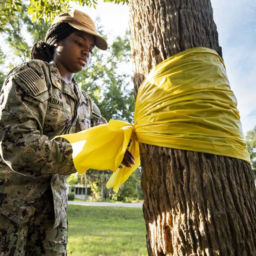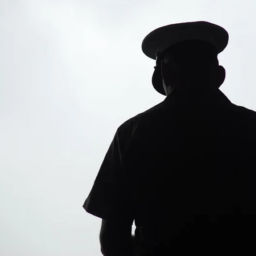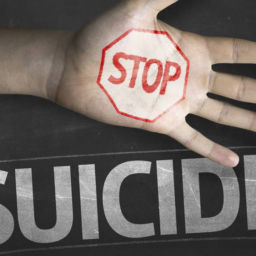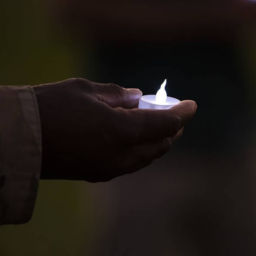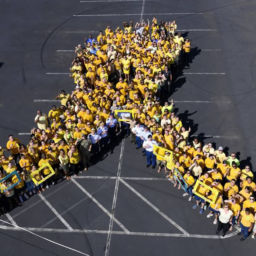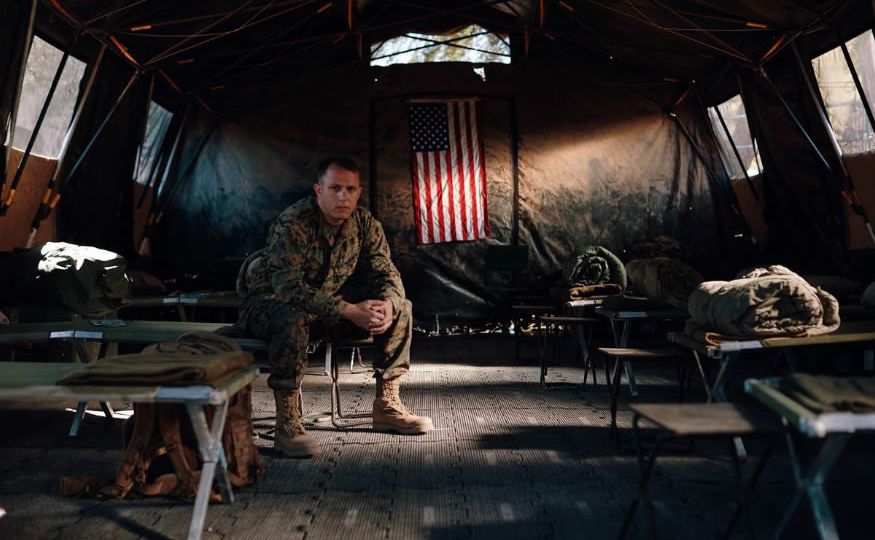
Article originally posted on the USO website – View
Article Author – Danielle DeSimone
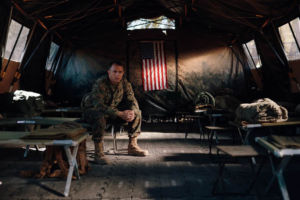
Suicide rates among active-duty military members are currently at an all-time high since record-keeping began after 9/11 and have been increasing over the past five years at an alarmingly steady pace. In fact, some branches of the Armed Forces are experiencing the highest rate of suicides since before World War II.
In 2021, research found that 30,177 active duty personnel and veterans who served in the military after 9/11 have died by suicide – compared to the 7,057 service members killed in combat in those same 20 years. That is, military suicide rates are four times higher than deaths that occurred during military operations. For military families and parents, whose active duty loved one already sacrifices so much to protect our freedom, this trend is extremely troubling.
Several causes can lead a person to commit suicide, but for active-duty service members, there’s an additional layer of potential stressors on top of the regular ups-and-downs of life that puts them at risk.
In light of this heartbreaking trend, the USO has developed special programming in line with the Center for Disease Control’s (CDC) strategies to prevent suicide to support service members in need, even in the darkest of times.
Strengthening Service Members Through Connection
Service members who are stationed in other countries or deployed to combat zones often experience loneliness and isolation. They must spend months – sometimes years – away from family and friends in unfamiliar locations, while dealing with the stress and dangers of their daily duties. In fact, according to the Blue Star Families 2021 Military Family Lifestyles Survey, 8 in 10 active-duty respondents have been separated from their families in the past 18 months due to military service, and 31% have been separated for a total of six or more months.
It can also be difficult to bond and spend time with fellow service members, depending on the location and resources of their assignment.
This is a serious issue for the morale and mental health of our nation’s military, which not only impacts operational readiness, but also the personal lives of those in uniform.
According to a 2018 study, “social connections can act as a buffer against the impact of stressful or negative life experiences on mental health.” The International Association for Suicide Prevention and the World Health Organization (WHO) also cites social connection as a crucial method in preventing suicide.
This is exactly why connection is at the heart of everything the USO does for active-duty military members and their families.
All around the world, USO centers provide programs that aim to strengthen service members by providing them with the ability to connect with both their loved ones back home and with their battle buddies serving with them in-country. To ensure that service members can keep in touch with friends and family, even on deployment, centers are outfitted with free Wi-Fi, computers and international phone calling.
“My husband is deployed at the base [in Kuwait],” said a military spouse in 2018. “It is nice to know he can go there … if he just wants some company. It really eases my mind when he is half a world away.“
In USO locations such as the Middle East and Eastern Europe, the Bob Hope Legacy Reading Program is especially popular. Through this, deployed service members can walk into a USO center, record themselves reading their child’s favorite book and have that recording shipped home. Many military parents credit the program with helping them feel as if they are back with their family, “even if just for one story.”
“The most special thing is staying connected to your family by sending them a personal message, especially in a time when it’s not always possible to stay in contact with your loved ones,” said a U.S. Army soldier who has used the Bob Hope Legacy Reading Program to keep in touch with his 2-year-old daughter while deployed to Hungary in 2022, in response to the war in Ukraine.
Throughout the COVID-19 pandemic, isolation became a global issue – but especially so for service members in quarantine. With military suicides increasing by 16% throughout 2020, the risks of isolation during quarantine in the military were noteworthy. Those infected while serving overseas, or troops who returned from deployment, were required to first complete a mandated 14-day quarantine before returning to duty or before finally being allowed to head home. These quarantines were made even more challenging by the fact that service members were not only isolated from others in their unit, but also from their loved ones and home.
To help alleviate the isolation of quarantine, the USO supported these service members by providing free Wi-Fi, USO Care Packages, homecooked meals and virtual entertainment.
USO overseas locations also host events throughout the week for unaccompanied service members (that is, stationed in locations without their families) to spend time with each other in a non-work environment, to foster a sense of home and community. Seemingly simple events like movie nights, a shared meal, kickball games and Super Bowl watch parties provide service members with an opportunity to leave their barracks, spend time socializing with others and enjoy a safe, supportive environment to relax off-duty.
These kinds of events ensure that even when service members are far from home and dealing with life on the front lines, they can still fight those feelings of isolation and loneliness by leaning on one another.
“The USO gives us a little bit of home, keeps us connected to home,” said a U.S. Army soldier during a deployment to Poland in 2022, in response to the war in Ukraine. “And that helps with separation [from loved ones].”
“If you get time to just come in here, sit, relax, read a book, read a book to your kids, talk on the phone, call home, get on the internet, on the computer … just little things like that, just goes a long way for morale … because if you don’t have an outlet, you drive yourself crazy,” said a deployed service member in Kuwait in 2019.
Strengthening Service Members Through Protective Environments
According to the World Health Organization, having a safe, supportive environment plays a large role in suicide prevention. When people feel secure in their surroundings, they experience less anxiety and depression, improve their physical health, have fewer instances of substance abuse and experience an overall improved quality of life and life expectancy.
However, in the U.S. military, a safe, supportive environment isn’t always guaranteed and can be extremely difficult to come by, particularly during moments of extreme change, like deployments or cross-country moves.
That’s why USO centers are strategically located in airports and military installations all around the world. When a service member sees a USO center, they know that from the moment they walk in, they can depend on the center to have a safe, supportive environment, no matter if they are in Pennsylvania or Poland.
“In between my journey from home and my duty station, the USO was a very comforting place for me … when I arrived, the place was buzzing with life and unity. The workers were very gracious and welcoming,” said one active-duty service member in 2019.
Inside a USO center, service members can enjoy a relaxing, home-like atmosphere outfitted with comfortable couches, televisions, Wi-Fi and other thoughtful touches. On bases and installations, military spouses and children can use USO facilities as a gathering space to build community or make new connections. In combat zones, USO centers are a safe haven for service members on the front lines who simply need a place to think about anything other than the fact that they are deployed.
“Currently on yet another deployment to Iraq and the USO ladies have really been a pleasure,” said an active-duty service member in 2019. “If I never forget anything about all that I’ve done [here in Iraq] it will be their kindness and their homemade bread they’d make daily that would transport me home.“
When everything feels uncertain and unfamiliar, service members and the rest of the military community can rest easy knowing that no matter what USO center they walk into, they’ll be supported and welcomed with open arms.
Strengthening Service Members by Supporting Mental Health
According to the Mayo Clinic, “most often, suicidal thoughts are the result of feeling like you can’t cope when you’re faced with what seems to be an overwhelming life situation.”
That’s why USO centers do more than just improve morale through a welcoming environment – they also provide programming that aims to tackle real-life problems, such as financial strain, that are often responsible for mental stress that can lead to suicide.
This is significant, as active-duty service members surveyed by the Blue Star Families’ 2021 Military Family Lifestyle Survey cite financial stress as one of the top issues facing their families.
For service members and military families struggling to make ends meet between paychecks, meals at USO centers, funded by generous donors, help supply healthy, home-cooked meals for free – no questions asked — and a night off from making dinner.
“The USO Dinners were a lifeline for me as a tired mom, who was doing it all on her own, while [my husband] was away overseas,” said a Navy spouse in 2018.
The USO also assists military families by giving them the tools to set themselves up for success – both professionally and financially – through the USO Pathfinder® Transition Program. This program provides free, customized professional development support at any time in a service member or military spouse’s career, including action plans, programs and resources focused on job-seeking, education, financial readiness and mentorship. Participants in the program are assigned an individual USO Transition Specialist who assists them one-on-one in their educational and professional aspirations.
Additionally, when the unexpected happens – such as a government shutdown that suspends the pay of the Coast Guard for an entire month – the USO is ready to provide everything from free diapers and groceries to a place for military families to gather.
Some of the most important support the USO provides to assist in preventing military suicide comes from USO Warrior Centers. These centers – located in Landstuhl, Germany; San Antonio, Texas; Bethesda, Maryland and Fort Belvoir, Virginia – were built specifically with injured, ill and wounded service members in mind. They feature amenities like ADA-compliant spaces, outdoor gardens, communal kitchens and special programming tailored to engage recovering troops with both visible and invisible wounds, who are particularly at risk for suicide.
USO Warrior Centers provide service members recovering at nearby medical facilities with classes in art, cooking, yoga and music. These classes are far more than just relaxing activities – they have been proven to help service members and veterans better express themselves, as well as reduce pain and anxiety. Music, in particular, helps service members cope with PTSD and other injuries as a result of their service.
There is also, of course, the benefit of simply having a listening ear from a fellow USO patron – whether that be from a service animal or a liaison officer whose only job is to ensure the morale of wounded service members by something as simple as a board game.
“Anybody who is wounded, ill or injured, it’s a sensitive experience, certainly a more challenging experience,” said Konrad Braun, area director of USO Kaiserslautern.
“I think it’s important to have a USO here to provide the amenities that the Warrior Center provides to help them basically get through that more emotional experience.”
Suicide among active-duty service members is a problem. It is an issue that cannot be easily fixed, but it is one that should be addressed. Thanks to our donors, the USO can continue to always be at the side of our service members, supporting them in any way necessary.
Article originally posted on the USO website – View
Article Author – Danielle DeSimone


